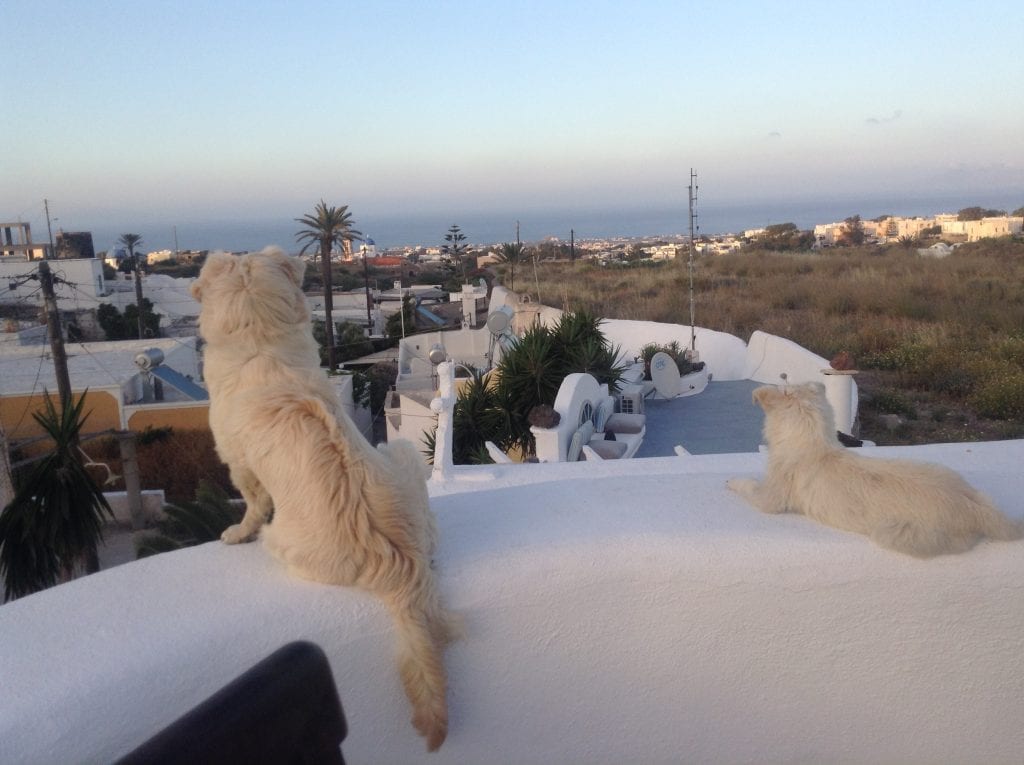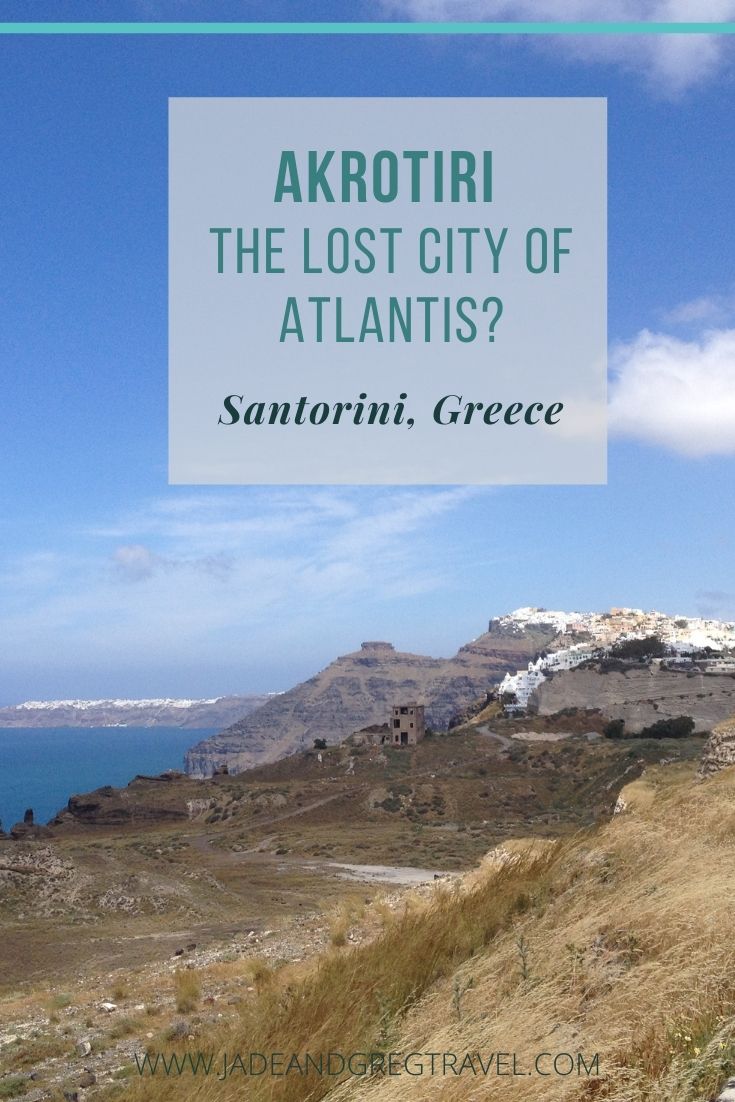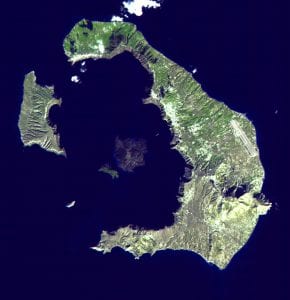Ancient Akrotiri - Lost City of Atlantis?
Table of Contents
Akrotiri is a wonderful ancient city to visit whilst you are on the Greek island of Santorini. It is a prehistoric bronze age settlement which was lost to the world after a huge eruption in the 16th Century BCE… and has been suggested to be Plato’s lost island of Atlantis.
Originally known as Thera, after after the mythical ruler Theras, who migrated there.
True to my love of history (and considerable lack of memory) we decided to hire a guide to take us around this interesting site.*
Discovery
The ancient Minoan city was discovered properly in the 1960s by a Greek archeologist Professor Spyridon Marinatos. Previously small excavations nearby by French and German archeologists had revealed little but it was Professor Marinatos’ find that revealed the full value of the site. It was his life’s work and he also died mysteriously on the site too.
History of the Site
There is evidence of human settlement to 4,000BCE way back in the Neolithic period, where it was a small fishing and farming village on the rocky island. But it grew to become a primary port between Cyprus and Minoan culture on Crete (remember the Palace of Minos and the Minotaur myths?). A huge amount of copper moulds and crucibles have been found making it likely to be an important centre for processing copper.
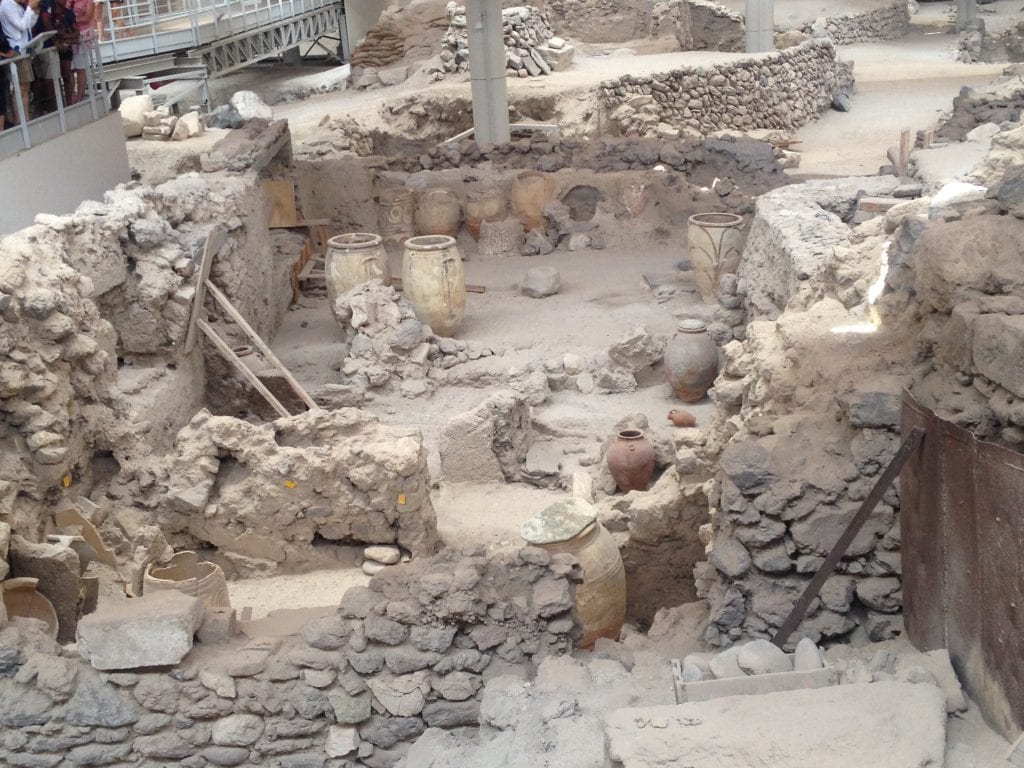
Who lived there?
Only 3% of Akrotiri has been unearthed but what we do know is that it was a prosperous city with wealthy citizens. With paved streets, amazing drainage, beautiful pottery and crafts.
All houses were beautifully decorated, some three stories high (very unusual for this early age). They had underfloor heating, running water and flushing toilets on the second floor!
There is an elaborate plumbing/draining system throughout the city, they even had plumbing on second floors! Ironically the archeologists excavating these amazing plumbing works, had to use primitive drop toilets which was all the island had in the 1960’s.
There is no evidence of a palace like the contemporary civilization of Minoan Crete, so we assume it was a democratic society.
On the site you can see the people’s beds, handmade tables, jars and a metal bath.
Amazing, finds, but no human remains or jewellery….except 2 years ago they found one gold Ibex/Goat figure under the floor boards.
“Any archaeologist who delves into the ruins
of the town has the feeling that he is witnessing the history
of a consumer society.”
Christos Doumas, Director of the Akrotiri Archaeological Excavations
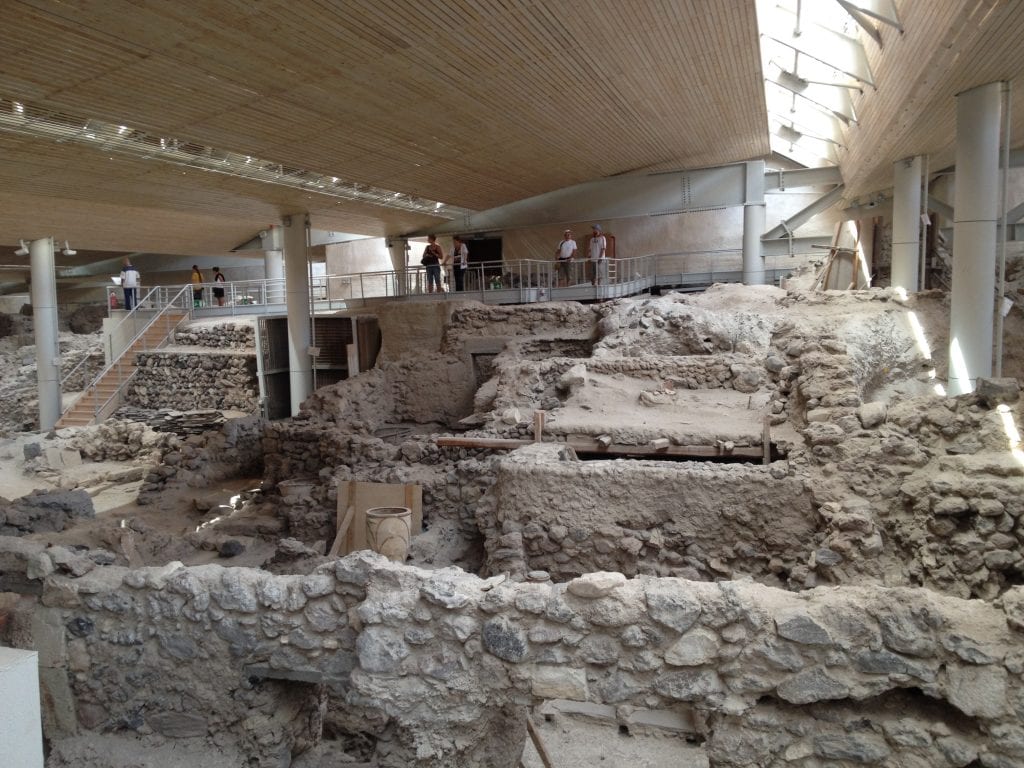
How did it end?
It was destroyed in a volcanic eruption of 1600 BCE and buried in volcanic ash, this was a HUGE eruption and mentioned in far reaching accounts, like the Egyptian Tempest Stele and Chinese Bamboo Annals!
The lack of bodies (human remains) or jewellery (unlike Pompeii) leads us to believe that the Akrotiri people had an orderly evacuation.
They knew in advance the volcano would blow and everyone left before this happened. Kind of amazing to think these days they could get everyone to just leave their houses and belongings.
Whereas the Minoan civilisation on Crete was devastated and declined. How is it these people were so advanced?
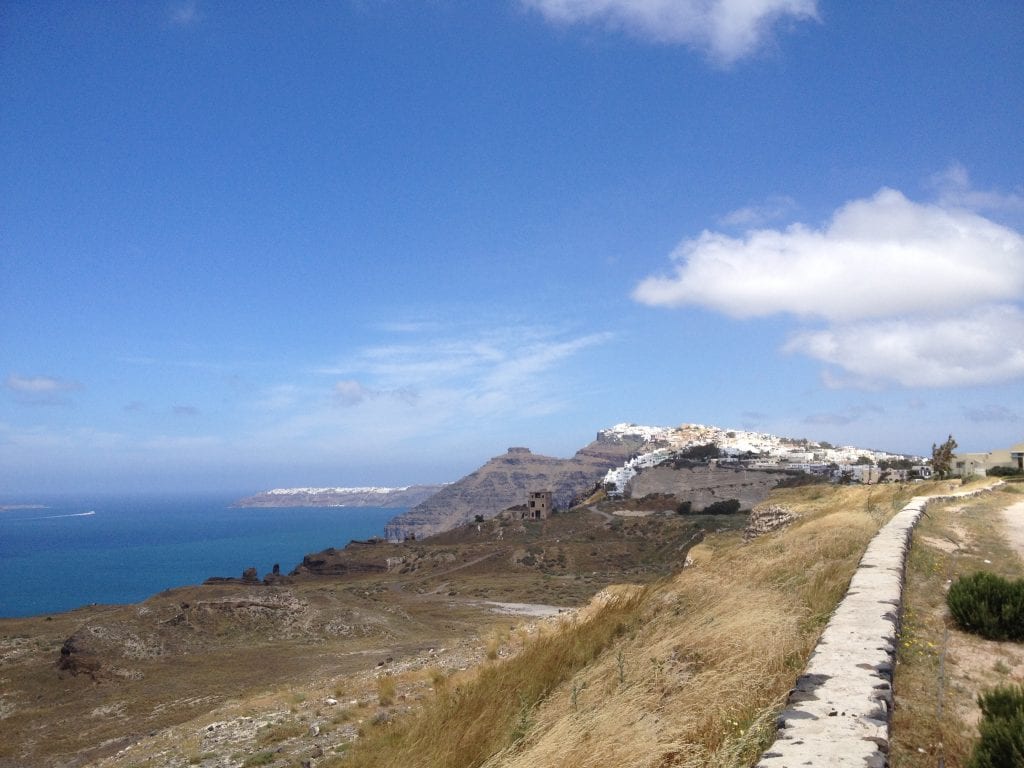
Is this Atlantis?
It has been suggested that it was Plato’s inspiration for the myth of Atlantis.
Before we start theorizing it’s good to know where the myth of Atlantis came from – this was news to me as I’ve seen many new age programmes trying to pinpoint it but actually doing some research I realized that Atlantis might have just been a made up example to illustrate Plato’s point that Athens is superior!
Atlantis was first mentioned by Plato in his work “Timaeus & Critias” where it was described as the enemy naval power that besieged ancient Athens. In the story Plato mentions it was first heard by Solon in ancient Egypt, then transmitted orally until his character Timaeus heard it….(suspect origin if you ask me!).
The story goes that Athens repels the Atlantean attack, and because of Athen’s superiority (it was Plato’s ideal state in The Republic) Atlantis fell out of favour with the gods and was submerged into the sea (or buried under volcanic ash – I mean you interpret it how you want!)
“But afterwards there occurred violent earthquakes and floods; and in a single day and night of misfortune all your warlike men in a body sank into the earth, and the island of Atlantis in like manner disappeared in the depths of the sea”
Plato (360 BCE). “Timaeus”. Translated by Benjamin Jowett. Retrieved 16 August 2016.
See the hole where the volcano would have sat making it a circular island….
So the evidence that Santorini could be Atlantis is:
- According to our guide, this island was nicknamed “circle” by the Greeks, which apparently Atlantis was also known as.
- Both Akrotiri and Atlantis were an advanced society, who had very wealthy upper classes.
- Both Akrotiri and Atlantis suffered an abrupt end. Plato suggested the Atlanteans had too much hubris, so the gods punished them by sinking the island. In reality Akrotiri did suffer an abrupt end due to a volcanic eruption.
- The volcanic eruption and Atlantis’ submersion seem to be within the same time period.
- Atlantis the island was submerged by the gods due to the people’s hubris. Whilst Akrotiri, the city was buried under ash, the main part of the island (the volcano and surrounds) ended up submerging into the ocean leaving a half moon crescent of Santorini today.
Amazing, so glad we did a tour with an archeologist.
Visiting Info
It is on the south east coast of Santorini, just a few kilometres from Akrotiri village. From Fira it is just under 30min drive, or you can get a cheap bus for a few euros and it drops you off right in front of the site.
The museum is open year round.
Tickets cost 12 / 6 Euros
You can hire an English/Spanish speaking guide outside the site.
Website: http://odysseus.culture.gr/h/3/eh355.jsp?obj_id=2410
Opening Hours:
Summer – 15 April – 31st Oct
Open every day with slightly shorter hours on Wed.
Thurs – Tues 08:00 – 20:00
Wed 08:00 – 15:30
Winter – 6 Nov – 31st March
Wed – Mon 08:30 – 15:30
Closed Tuesdays
Tour Guides: Whilst you do have to be careful at some sites, Akrotiri had recommended guides. If you are a history buff I do highly recommend it, as hearing someone tell you stories really makes the site come alive!
Nearby
Museum of Preshistoric Thera & Archeological Museum of Thera
These are both rather small museums & close to eachother. They are great to visit especially after you’ve seen Akrotiri. They have some of the more beautiful pots and wall paintings from the site and its great to see them up close to understand more about this lost culture.
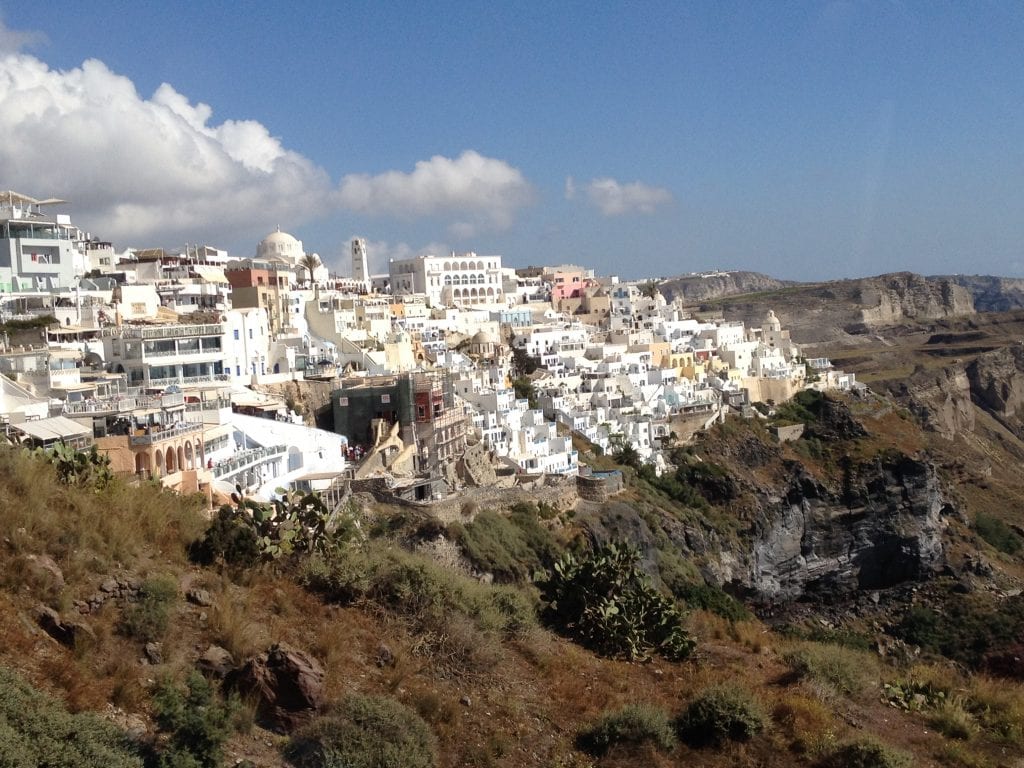
Red Beach
One of the more famous beaches on the island. It was quite chilly in May when we were there so sunbathing on this side of the island wasn;t too warm!

Cave of Nicholas
Don’t miss the Cave of Nicholas for lunch. Which was originally a fisherman hangout and hand carved cave for old Nicholas’ fishing boats.
In the 60’s the archeologists came, they suggested that old man Nicholas & his wife could sell them some Greek food and drinks as it was close to the archeology site of Akrotiri. It did so well and still operates today!
Now run by their children, it is a lovely stop after visiting Akrotiri and the food is delicious! We had a huge seafood platter! Sitting right by the water, just outside the cave.

Wine Museum
Off to the wine museum on the vineyards of a Greek family who came to Santorini in the 1900s. Deep underground in an 800m long cave that is 15m deep are the storage and wine making facilities. The tour includes a guided audio tour with cute scenes showing how wine is made. The actual squashing grapes was done by foot in these caves, and you can see foot press and the rooms with funnels to dribble pressed juice. A rather musty wine smell throughout the place. Great tour and shows traditional winemaking from then till now. Then you get to taste the wine – best bit!
Santorini is famous for ‘vinsanto’ a sweet wine they make only on the island.
Yum.
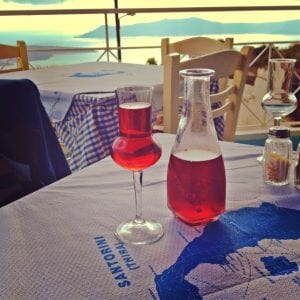
Stay
Roubeti Village – has an amazing pool, a bbq area and lovely people.
